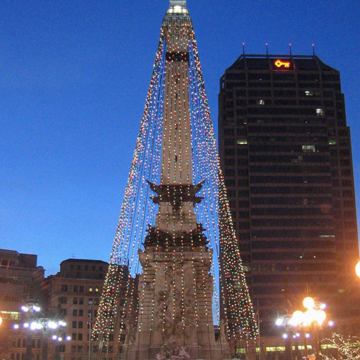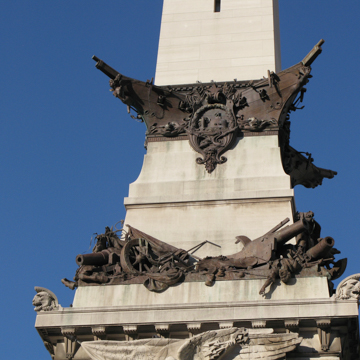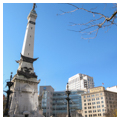You are here
Indiana State Soldiers’ and Sailors’ Monument
For generations, the Indiana State Soldiers’ and Sailors’ Monument has defined Indianapolis’s downtown and served as a symbol of the state’s capital city. The Monument itself and the surrounding Monument Circle are one unified entity, being both the most recognizable object and the most prominent public space in Indiana. This is one of the largest and most commanding state war memorials in the United States and reflects the importance of the commemoration of veterans’ service in late-nineteenth-century America.
The Monument occupies a circular block at the precise center of Alexander Ralston’s mile square plat of Indianapolis of 1821. Ralston had served as an assistant on the survey of Pierre Charles L’Enfant’s plan of Washington, D.C., and his plan for Indianapolis took many cues from L’Enfant. The Circle was originally planned as the site for the governor’s house, with squares for the state capitol and county courthouse equally spaced to the east and west. A governor’s residence, also designed by Ralston, was completed on the site in 1827; never occupied by a governor, it was demolished in 1857. The Circle served as a cow pasture until 1867, when it was landscaped, enclosed with a fence, and renamed Circle Park.
During the Civil War, Indiana contributed more than 196,000 soldiers and sailors to the Union forces. This was 74.3 percent of the state’s citizens capable of bearing arms, higher than any state in the Union except Delaware, and exceeded there only by half of one percent. After the conclusion of the war, Indiana’s large veteran population became a major political force within the state. In 1887, following several unsuccessful monument campaigns, the Indiana General Assembly passed a bill committing the state to build a monument in Circle Park honoring Hoosier veterans of the Civil War.
Unusual for a state memorial, an international competition was held to select a design, and ten prominent American architects, including Richard Morris Hunt, George B. Post, Burnham and Root, and Peabody and Stearns, were invited to submit entries. The 70 anonymous submissions ranged from small memorial chapels to neo-Renaissance campanili to triumphal arches to victory columns, most following standard memorial precedents. One design stood out among the rest. It featured a square column 265 feet in height, rising from a large pedestal surrounded by and encrusted with extensive allegorical sculpture. Rather than sitting as an object within Circle Park, this design engulfed the entire site, cascading down to the sidewalk line in layers of stone terraces, staircases, fountains, and groups of sculpture. The Monument design contained a staircase and elevator providing access to an observation platform beneath an immense statue of Victory.
This winning entry was prepared by twenty-nine-year-old German architect Bruno Schmitz. Virtually unknown in the United States, Schmitz had achieved some notoriety in Europe, taking first place in an 1883 competition for a monument (unexecuted) to Italy’s Victor Emmanuel II. He had studied under Düsseldorf architect Otto Lieber (1825–1897), whose brother Hermann, was the head of a prominent Indianapolis family. Schmitz opened an architectural office in Berlin in 1886. His victory in the Indianapolis competition offered an incredible opportunity for the young architect to realize a design of colossal scale. Schmitz soon received commissions to design numerous, often immense and dramatic, nationalist monuments around Germany under the direction of Kaiser Wilhelm II.
When construction of the Soldiers’ and Sailors’ Monument began in 1888, it was to be the third tallest monument in the country, behind the recently completed Washington Monument and Statue of Liberty. The Monument was initially intended as a memorial to Hoosier veterans of the Civil War, but in 1892 the State expanded its purpose to commemorate Hoosier veterans of all previous wars.
Schmitz’s design featured a large quantity of allegorical sculpture, including individual commemorations for the various branches of the military along with figure groups representing War and Peace. The Monument’s bronze figures and astragals were designed and executed by George T. Brewster of Cleveland and Nicolaus Geiger of Berlin. After several competitions and false starts on the design and execution of the monumental allegorical stone sculpture groups, Austrian-born Berlin sculptor Rudolf Schwarz (1865–1912) was brought into the project. Both Geiger and Schwarz had worked with Schmitz on nationalist monuments in Germany.
The Indiana State Soldiers’ and Sailors’ Monument was dedicated in 1902 after fourteen years of construction. The Circle was renamed Monument Place at this time, though it soon became known as Monument Circle. The Dedication Day festivities included multiple grand parades, three hours of dedicatory exercises, military drills, and several flag ceremonies. Many prominent Hoosiers played a part in the day, including General Lew Wallace, author of the best-selling novel Ben-Hur (1880) and nationally renowned poet James Whitcomb Riley. The day was concluded with an evening torchlight procession followed by a huge display of red, white, and blue fireworks in the sky over the monument.
Since its completion, the Soldiers’ and Sailors’ Monument has been the most prominent structure in Indianapolis, serving as a center for all manner of public events, from victory parades and presidential speeches to football fan rallies, holiday celebrations, and political demonstrations. Every year since 1962, strands of lights have been strung between the top of the Monument and its upper terrace to form an enormous Christmas tree. The Monument underwent a comprehensive restoration during the 1980s. In scale and artistic quality, the Monument set the precedent for the following generation’s construction of the five-block-long Indiana World War Memorial Plaza, designed by Walker and Weeks. Although it is no longer the tallest building in Indianapolis, the Monument remains a key landmark and the point of reference for directions in the central part of the city.
References
Competition for the Design for the State Soldiers’ and Sailors’ Monument, for the State of Indiana. Indianapolis: State Soldiers’ and Sailors’ Monument Commission, 1888.
“Competitive Designs for Indiana State Soldiers’ and Sailors’ Monument, Indianapolis.” Inland Architect and News Record11 (1888).
Grimaldi, Anthony Eugene. The Indiana Soldiers’ and Sailors’ Monument and its Dedication: A Study of a Nineteenth Century American Monument and its Allied Arts of Pageantry. PhD diss., Ohio University, 1982.
Ralston, Alexander. Plat of the Town of Indianapolis. Columbus, OH: H. Platt, 1821.
Ross, Benjamin L. “The Indiana State Soldiers’ and Sailors’ Monument: German Nationalism and Hoosier Commemoration of the Civil War.” Paper presented at the 27th Annual Meeting, Southeast Chapter of the Society of Architectural Historians (SESAH), Jackson, Mississippi, 2009.
Selm, William L. “Soldiers and Sailors Monument.” Encyclopedia of Indianapolis. Bloomington, Indiana: Indiana University Press, 1994.
Stempfel, Theodore. Artist’s Life: Rudolf Schwarz and Karl Bitter. Indianapolis: Max Kade German-American Center and Indiana German Heritage Society, 2002.
Writing Credits
If SAH Archipedia has been useful to you, please consider supporting it.
SAH Archipedia tells the story of the United States through its buildings, landscapes, and cities. This freely available resource empowers the public with authoritative knowledge that deepens their understanding and appreciation of the built environment. But the Society of Architectural Historians, which created SAH Archipedia with University of Virginia Press, needs your support to maintain the high-caliber research, writing, photography, cartography, editing, design, and programming that make SAH Archipedia a trusted online resource available to all who value the history of place, heritage tourism, and learning.















